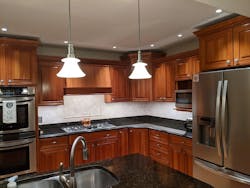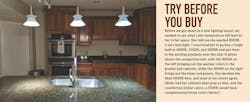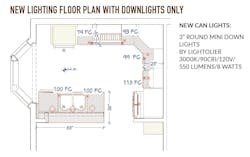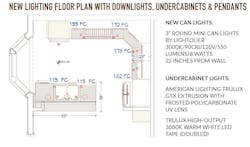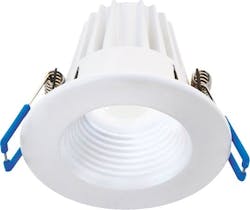Better Kitchen Lighting in 3 Steps
Most U.S. kitchens are woefully underlit, and this kitchen in Maryland was no exception. The owner, Joanne, knew it and went online to find help. That’s where she ran across prior lighting articles I’d written for Pro Remodeler. She emailed the magazine and we were able to connect.
It turns out that Joanne’s kitchen displayed three of the most common mistakes: lights in the wrong location, the wrong type of lights, and not enough lights.
Here, I will discuss the problems I found and solutions for each one.
Kitchen lighting before
Problem #1: Lights in the Wrong Location
Joanne’s kitchen has cherry cabinets, very dark granite, and just three small recessed cans. The lights illuminated the upper cabinets but didn’t seem to be delivering much usable light down the counters. And there was no undercabinet lighting. The biggest part of the problem was that the recessed cans were floating out in space, about 39 inches off the walls, a good 14 inches beyond the counter edges.
This meant the light was hitting the back of Joanne’s head when she stood at the counter and did little to illuminate the task. This is a very common problem, as for decades, kitchen designers have been told to keep the recessed fixtures away from the upper cabinets.
Fortunately, that is changing.
RELATED: Undercabinet Lighting Dos & Don’ts
Problem #2: The Wrong Type of Lights
The size and type of lamp (bulb) determine the amount of usable light on the task. Even if the existing small 4-inch cans had been located directly over the countertops, they were only PAR 16 lamps (300 lumens, 6 watts) and were capable of putting down just 40 foot candles (fc) maximum. What Joanne needed were PAR 20s or PAR 30s which could have delivered enough. (This requires a 5-inch can.)
For a kitchen, PAR lamps are far superior to the more common BR (Bulged Reflector) lamps. PARs put out 10 to 20 times the illumination than BRs, and with a tighter beam angle, are far less likely to deliver glare. (See “Lighting: Theory Meets Practice” March 2018). And both types of lamps are far superior again to the latest rage “canless downlights” (aka “Canless LEDs, “Surface Mounted Downlights”).
These wafer-thin LED discs look like a can but blast out illumination in all directions with massive glare and little illumination delivered to the work surface. Cheap? Yes. Effective? No. The other lights in Joanne’s kitchen were pendants along the sink peninsula and a short curved track fixture floating out in the middle of the space, illuminating nothing.
I asked Joanne if she could measure the light levels in her kitchen and send a sketch with the location of each light and its level. (There’s a great app for measuring light called Light Meter Pro.) Joanne’s highest light level was 41 fc in one spot next to the refrigerator, but the rest of her kitchen averaged 18 fc in critical work areas. Moreover, she didn’t even actually have 18 fc of usable light because when she stood at the counter, she was blocking the light from behind her, and the readings were down to low single digits.
The very minimum the National Kitchen & Bath Association (NKBA) and the Illuminating Engineering Society recommend for kitchen counters is 50 for younger clients and 100 for older adults.
RELATED: Bathroom Lighting Guidelines
Problem #3: Not Enough Lights
Joanne’s kitchen only had three recessed cans, and they were too weak to properly illuminate the counters. Her new plan called for cans that would illuminate every critical work area at 23 inches off the wall, dropping light directly down onto the task. We even added a couple of cans at the peninsula so she could still use the decorative pendants but have the cans for “heavy lifting.”
So now, instead of three cans, we would have eight 3-inch cans, plus new undercabinet lighting. Once the layout was firm, the task was finding the right lamp (bulb) that would deliver predictable and high light levels on the countertops. The final scheme I came up with used a generic Halo low voltage can with a specific lamp, a Soraa “Brilliant HL Series” MR16 9 watt I’Narrow Flood, 3000K, that promised 104 fc on the counters.
RELATED: Recessed Kitchen Lighting Reconsidered
Lightolier Mini Downlight
Joanne had a secret weapon: Her brother is an electrician. He wanted to use a dedicated Lightolier LED mini recessed can instead of the open can with a screw-in lamp.
At my suggestion, they bought one and experimented with it in the space. The Lightoliers worked wonderfully. Average foot candles were 98, which is close enough. This little miracle worker put out 550 lumens of 3000K light using just 8 watts. (x8 cans = 64 watts total) The CRI was 90.
I didn’t anticipate this good of a result, but wait, it gets better.
This little miracle worker put out 550 lumens of 3000K light using just 8 watts. (x8 cans = 64 watts total!) The CRI was 90. I didn’t anticipate this good of a result, as the published photometrics didn’t support that.
I had specified a high output undercabinet light to punch more light on the work surfaces and brighten under the upper cabinets. This is important for all kitchens. Joanne’s brother bought lengths of aluminum channel with a lens, and installed two lengths of LED tape in the channel. Again, something I’ve never done before, but will again! It is virtually impossible to achieve the required 100 fc with undercabinet light alone, but this comes close.
Joanne’s brother did the labor and supplied materials wholesale, but she estimates it would have cost her $12,000 retail to do the project, including a backsplash, drywall patching, and retexture. Of course, if this were part of a larger remodel, the cost would have been much less, as all the subs would have been there anyway.
Light Levels Now Average 152 Foot Candles
Now, we aren’t averaging 98 fc, we are getting an average of 152. Does she run all lights on full all the time? Certainly not, because she has dimmers to adjust the light levels. Today, she runs the undercabinets at 100% and the downlights at about 85% because at 100% the glare from her polished granite counter tops was too distracting. (Most designers are now steering clients to matte or honed options for this very reason.) Joanne took readings with the downlights at 85% and undercabinets on full, and her average reading was 141.
As a final enhancement, I recommended she add a row of LED tape on top of the upper cabinets to bounce light off the ceiling, which doesn’t add appreciably to the light levels, but is a gentle soothing indirect light.
I frequently encounter pushback from contractors, electricians, and even homeowners during rough-ins. They say that I’m trying to provide “too much light.” I beg to differ. A sunny day might measure 10,000 fc, so coming inside and trying to work with 30 fc or less is a strain. Hospital operating rooms typically provide 1800 fc on the patient.
Joanne mentioned that she had to adjust her schedule to do dinner prep tasks in the morning when sunlight came in through the windows; otherwise she was struggling to see. I asked her, “Where in the house did she have enough light?” She sent a photo of her sewing set up, where the sewing machine put out 50 fc, and the gooseneck lamp she had right next to the machine added another 220 fc. I knew from this that she would appreciate higher light levels.
Doug Walter has been an architect for 43 years. He is member of the Illuminating Engineering Society, where he serves on the “Lighting for Seniors and the Low Vision Population” technical committee. He also serves as a Subject Matter Expert for the NKBA, where he teaches lighting courses and helped write curriculum for their Lighting Badge. One recent kitchen received a 2022 NKBA national design award at KBIS.
